Six-Week Strength Training Workout Plan
This powerlifting-inspired series of strength training workouts will make you bigger and stronger

Powerlifting is not just for powerlifters. The sport itself involves participants attempting to lift as much weight as possible in the squat, deadlift and bench press, but even if you have no intention of targeting such an event, building your training around these three fundamental barbell exercises can benefit everyone.
Training for this trio of compound exercises involves full-body workouts that will help you to develop well-rounded, functional fitness and increase your overall muscle mass. Your core strength will improve tenfold – and given the big three lifts involve heavy weights and lots of muscle groups, you’ll get your heart pumping as well, so your cardiovascular fitness will also benefit.
Following a powerlifting programme will help you get leaner and fitter in double-quick time – just six weeks, in fact, if you follow the strength training plan below.
How to do these strength training workouts
Each strength training workout focuses on one of the lifts, starting with a relatively light exercises designed to mobilise your target muscles. You then perform the key lift before doing an “assistance move”, which will help iron out weak spots in the main lift. The final two moves focus on one of the other powerlifts so that you train that exercise twice a week.
Follow the sets, reps and rest instructions for each move to get the maximum benefit. Do each workout once a week for six weeks, aiming to increase the amount you lift each time. And make sure you make a note of how much you lift in each strength training session to keep yourself motivated.
How to warm up for these strength training workouts
This strength training plan is not for beginners, primarily because you’ll be using heavy weights throughout the workouts. That also means you need to consider your warm-up carefully, because for the best results you’ll need to be ready to lift big from the start of your workout, rather than half-arsing the first couple of sets while your body grinds into gear. In addition, those heavy weights mean the risk of injury to a cold body is all the greater.
In your warm-up, it’s crucial to target the muscles you’re actually intending to use in your workout, rather than just doing five minutes on a cardio machine getting your heart rate up. If you’re not sure what to do, start with this stretching warm-up routine, which will limber up all the key muscle groups you might be using, and then go into some workout-specific drills.
Sign up for workout ideas, training advice, reviews of the latest gear and more.
The easiest way to go about this is to run through a circuit of the workout you’re about to do using very light weights or an unweighted bar, or even no weight at all. That way you’ll be sure to prep the muscles you’re intending to test.
Workout 1: Squat
1 Kettlebell goblet squat
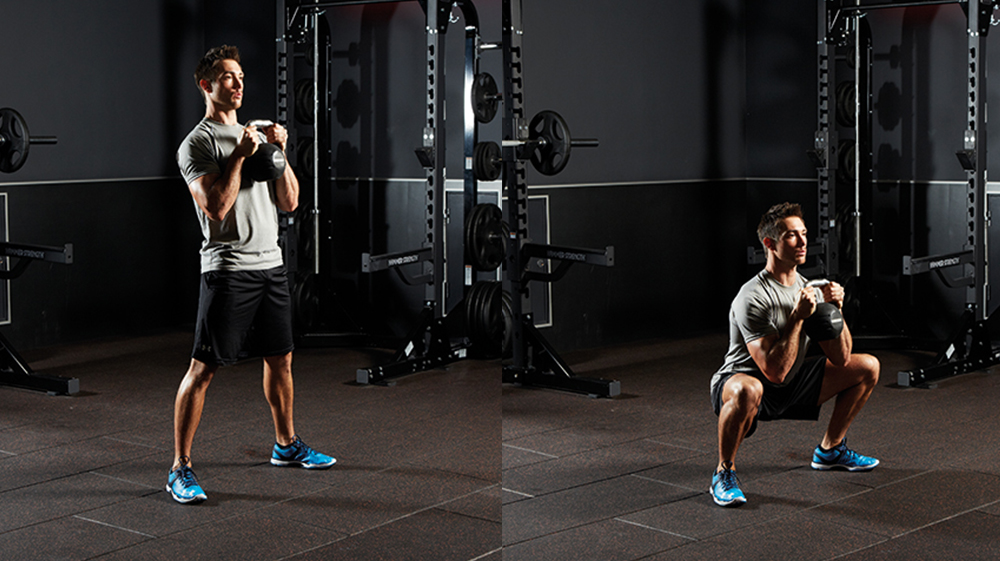
Sets 3 Reps 10 Rest 45sec
Why If you focus on touching your elbows to your knees then it’ll build the mobility you need for full-depth squatting, as well as flexibility in your groin and ankles, which makes it an ideal warm-up move.
How Hold the kettlebell with both hands in front of your chest, and squat down with your back straight and chest up. Descend until your elbows touch the insides of your knees, then put your weight on your heels as you stand back up.
2 Back squat

Sets 5 Reps 5 Rest 60-90sec
Why Squatting with big weights will build full-body muscle thanks to the huge growth hormone hit it prompts. It works not just your legs, but also your core, back and everything else below the bar.
How Hold the bar on your traps and stand with your feet roughly shoulder-width apart, toes pointing out slightly. Keep your back straight by looking at a spot on the floor about 2m in front of you, then sit back and down as if you’re aiming for a chair. Lower until your hip crease is below your knee. Keep your weight on your heels as you drive up.
3 Bulgarian split squat

Sets 2 Reps 8 each side Rest 60sec
Why This variation of the squat will target your quads – a key muscle group involved in heavy squats. It also works your legs independently so that you are equally strong and stable on both sides.
How Start with your back foot on a bench and your front foot approximately 60cm in front of the bench, holding a dumbbell in each hand. Bend at the knee to lower towards the floor, keeping your torso upright, then press back up to the start. Make sure that your knee is in line with your ankle and that your front foot is far enough forwards that your knee doesn’t travel in front of your mid-foot. Complete all the reps on one side, then switch.
4 Snatch-grip deadlift

Sets 3 Reps 10 Rest 60sec
Why Because your grip’s wider in this move, you’ll need to move the bar through a larger range of motion, increasing the growth hormone hit.
How Hold a barbell with your hands roughly double shoulder-width apart. Push through your heels and keep your chest up as you drive your hips forwards to lift the bar.
5 Kettlebell swing
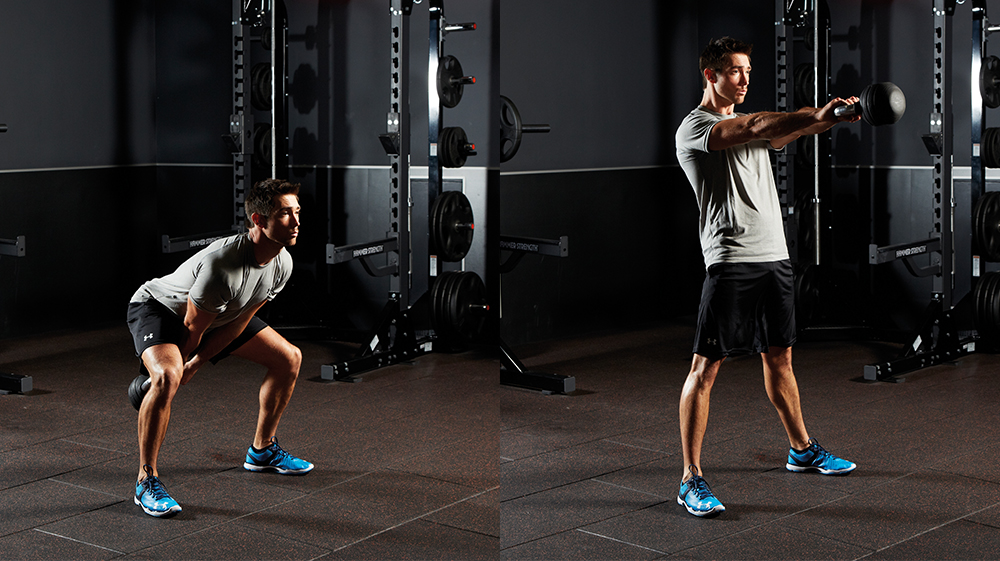
Sets 3 Reps 10 Rest 60sec
Why This full-body move engages all the muscles of your posterior chain – the ones involved in a deadlift.
How Swing the kettlebell between your legs with both hands, then pop your hips forwards to drive it up to head height, keeping your arms relaxed. Let the bell swing back into the next rep and don’t bend your knees much.
Workout 2: Deadlift
1 Kettlebell sumo deadlift

Sets 3 Reps 10 Rest 60sec
Why This version of the deadlift is a good way of drilling a movement pattern where you engage your hamstrings and hinge at the hips to perform the move. You’re using a fairly light weight so it won’t fatigue your muscles before you get to the heavy deadlift sets in the next exercise.
How Taking a wider stance than in a regular deadlift, place the kettlebell between your legs. Start the move by straightening your legs without changing the angle of your torso. Once your legs are straight, push your hips through to straighten up.
2 Deadlift
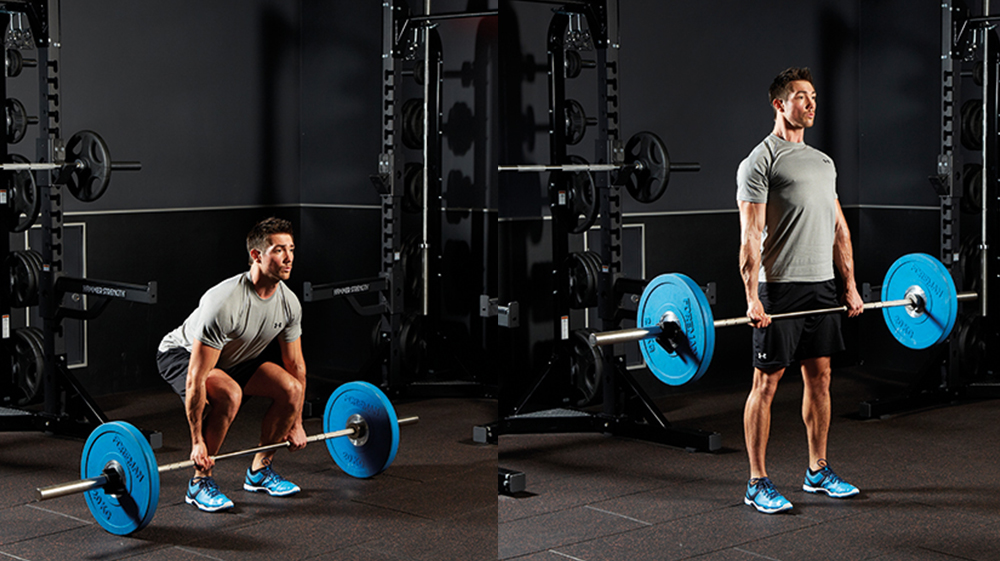
Sets 5 Reps 5 Rest 60-90sec
Why The deadlift is arguably the most effective whole-body strength and muscle builder. It also focuses on your posterior chain – the muscles on the back of your body, which often end up undertrained but play a key role in promoting good posture and keeping you injury-free.
How Set up so you grip the bar with an overhand grip , hands just wider than shoulder-width apart. Initiate the movement by loading your hamstrings and straightening your knees. Once the bar is past your knees you can straighten up fully.
3 Romanian deadlift

Sets 4 Reps 6-8 Rest 60-90sec
Why After your heavy deadlift sets this is an ideal way of developing the hamstring strength needed to improve your deadlift. It’s technically a lot easier than the deadlift so you’ll be able to go reasonably heavy even when your muscles are tired.
How Hold a barbell with an overhand grip just outside your thighs. Hinge at the hips to send the bar down the front of your thighs, ensuring that the bar stays close to you throughout the lift. Lower until you feel a strong stretch in your hamstrings, then straighten back up, contracting your glutes at the top of the move.
4 Incline bench press
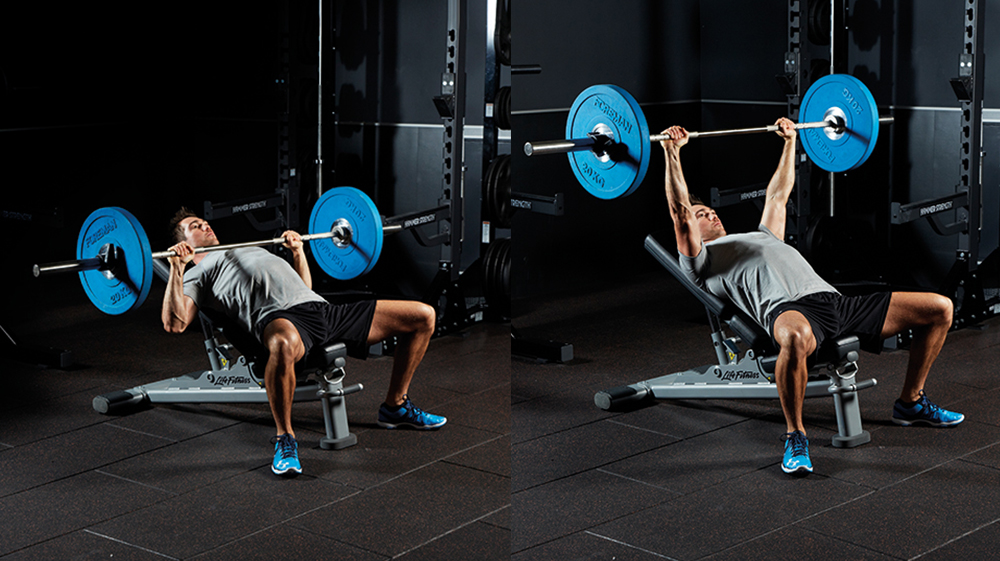
Sets 3 Reps 10 Rest 60sec
Why Setting the bench to an incline will mean you need to reduce the weight, but it’ll hit your chest from a new angle.
How Lie on a bench set at a 45˚ incline, holding a bar over your chest with your hands just wider than shoulder-width apart. Lower the bar until it’s touching your chest, then press it back up.
5 Press-up
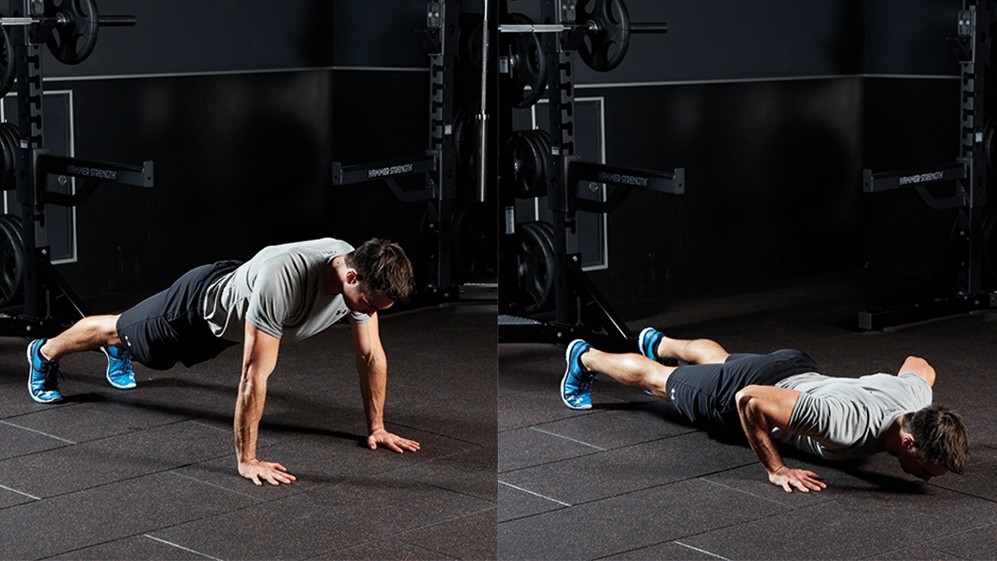
Sets 3 Reps To failure Rest 60sec
Why The classic go-anywhere chest builder will also work your core, as well as teaching you to hold full-body tension.
How Get into a press-up position with your hands just wider than shoulder width. Keeping your abs braced, lower until your chest touches the floor – keeping your thighs off it – and then press back up.
Workout 3: Bench Press
1 Dumbbell bench press
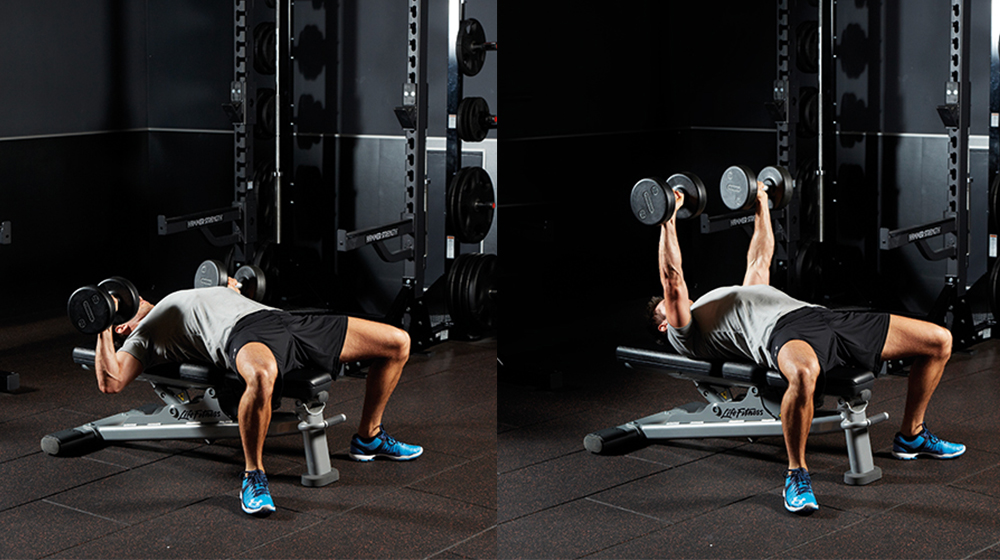
Sets 3 Reps 10 Rest 60sec
Why Using dumbbells for this classic strength training chest builder emphasises your pecs more than the barbell version, because the dumbbells move slightly inwards throughout the rep and also go through a greater range of motion.
How Lie on a bench with your feet on the floor directly underneath your knees. Hold the dumbbells above you with arms straight, then lower them to your chest. Then drive your feet hard into the floor and push the dumbbells back strongly to the start position.
2 Bench press
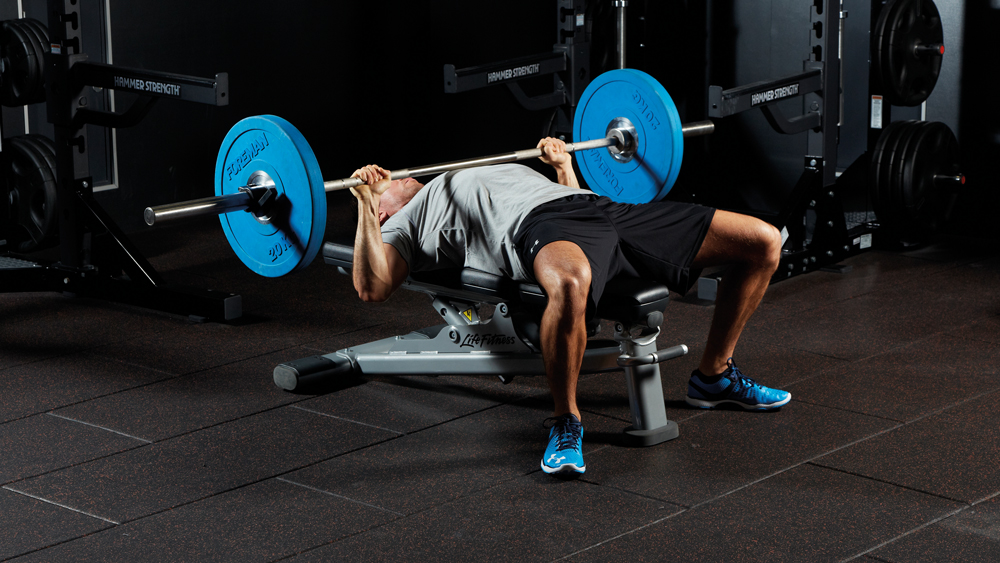
Sets 5 Reps 5 Rest 60-90sec
Why It’s a classic for a reason: a properly executed bench press (your feet should be pressing into the floor) will tax your whole body and allow you to use heavy weights to maximise upper-body development. Ensure your form is correct to avoid injury and maximise growth.
How Grip the bar with hands slightly wider than shoulder-width apart and squeeze your lats together to create a pressing platform before you take the bar out of the rack. Watch the ceiling, not the bar, to ensure you’re pressing in the same line each time. Lower the bar to your chest, aiming to brush your T-shirt without bouncing. Press up powerfully, pause at the top, then do your next rep.
3 Diamond press-up
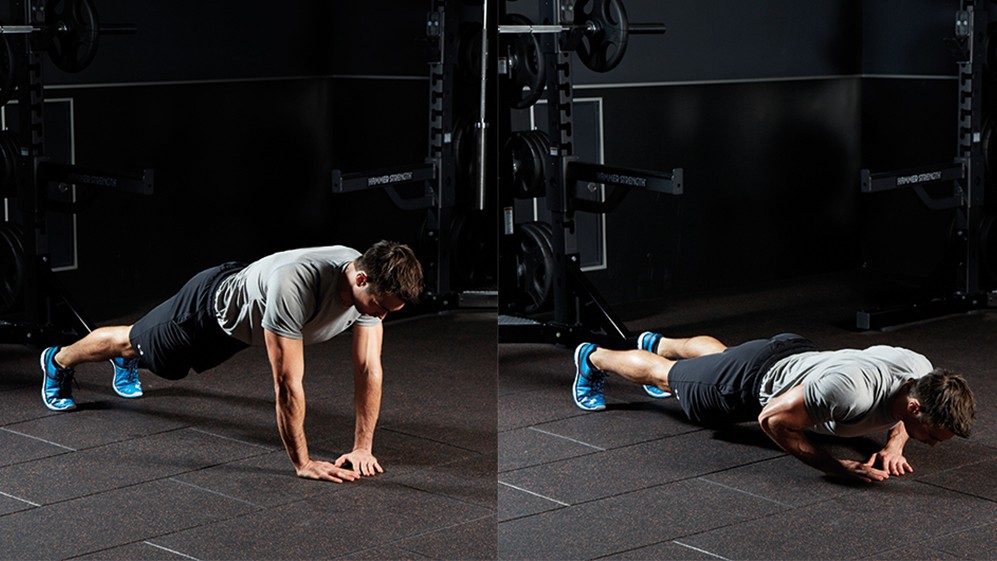
Sets 3 Reps 8-10 Rest 60sec
Why This press-up variation places extra emphasis on your triceps, while slightly changing the stress on your chest to hit it from a different angle.
How Get into a press-up position, placing your hands close together so your thumbs and index fingers touch. Keeping your body in a straight line with your abs braced, lower until your chest is just above the floor, and then press back up.
4 Front squat
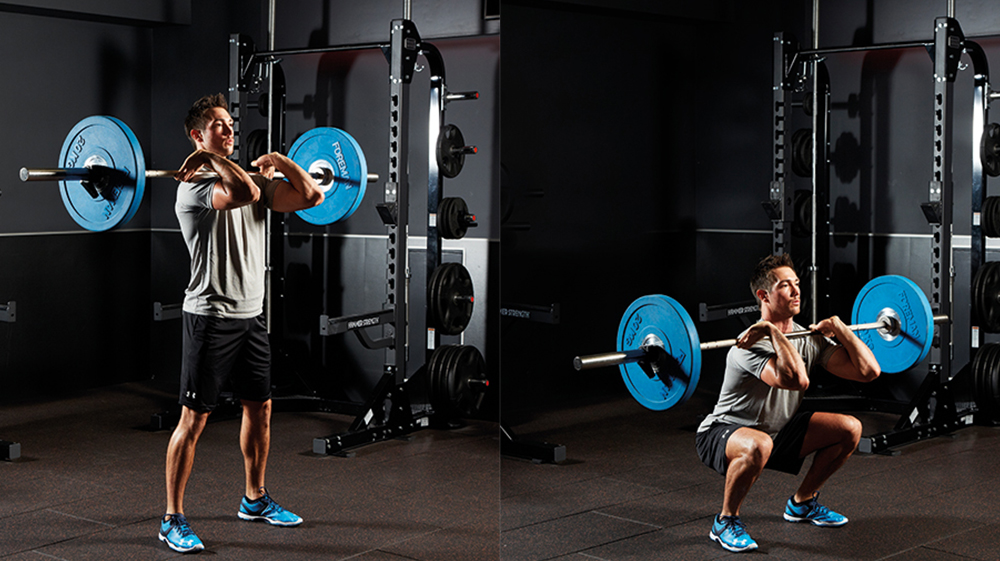
Sets 3 Reps 10 Rest 60sec
Why Shifting the bar in front of you moves the emphasis to your quads but also makes the move safer – you’ll be less likely to tip forwards and endanger your lower back.
How Take the bar out of the rack so it’s resting on the front of your shoulders and your palms face upwards. Squat down, keeping your chest up, then drive up through your heels to stand.
5 Dumbbell jump squat
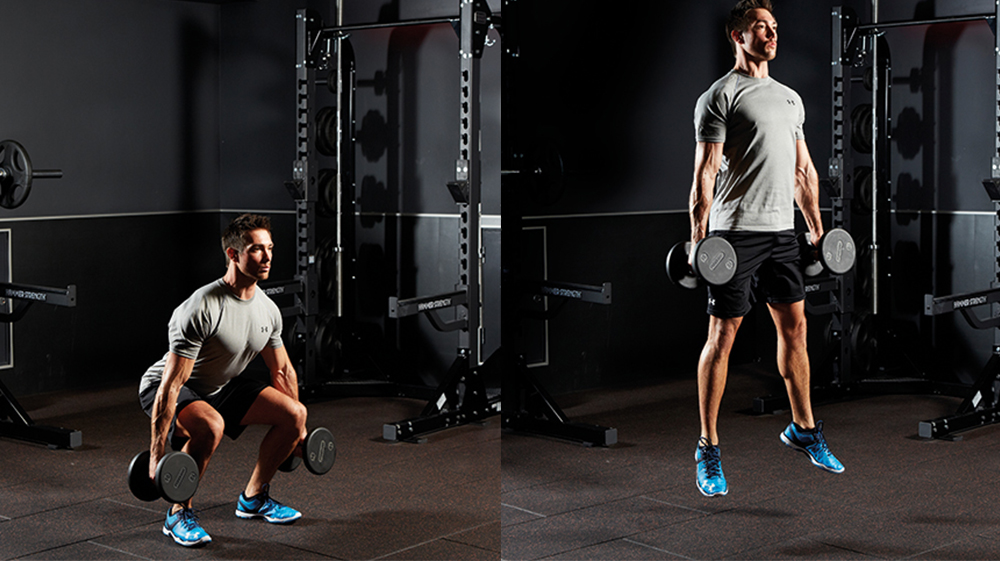
Sets 3 Reps 5 Rest 60sec
Why This explosive strength training move will activate your fast-twitch muscle fibres, priming your nervous system so you get maximum muscle fibre recruitment. The rep count is low because this is about quality of movement rather than exhausting your target muscles.
How Stand with feet shoulder-width apart, holding a dumbbell in each hand. Squat down, then explode up to jump as high as you can. Land softly and go straight into the next rep.
Diet tips
Follow this six-week plan to the letter and you’ll be taxing your body hard, so it’s crucial that you help it to bounce back by following a healthy diet. That means limiting how much alcohol you drink and how many takeaways you order, as well as making sure you eat a minimum of five portions of fruit and veg a day, starting to replace refined carbs with complex carbs, and making sure you’re eating enough protein (1.4-2g of protein per kilo of bodyweight per day when training this hard).
The good news is that it’s very easy to get enough protein through your diet rather than relying on supplements, and the additional micronutrients and other good stuff you get in food like lean meat and vegetarian proteins well help your body cope with the strain you’re putting it under. This seven-day meal plan for muscle gain can help you get started.
All this means that you need to put as much time and effort into preparing healthy meals at home as you do in the gym. If you’re new to the kitchen and could do with a helping hand while you develop your cooking ability, you can try recipe boxes or meal delivery services. You pay a premium for the convenience, but they tend to be far healthier than ready meals – and some meal delivery services offer consultations with nutritionists to design meal plans that support your efforts in the gym.
More About Strength Training
While we’ve laid out exactly what you need to do, it’s still worth familiarising yourself with these five common strength training mistakes to make sure you’re not making any unforced errors.
If you haven’t got access to a gym at the moment, find out how to start strength training at home, and for women, we have a guide to strength training for women featuring a beginner’s home workout plan.

Joe Warner is a highly experienced journalist and editor who began working in fitness media in 2008. He has featured on the cover of Men’s Fitness UK twice and has co-authored Amazon best-sellers including 12-Week Body Plan. He was the editor of Men’s Fitness UK magazine between 2016 and 2019, when that title shared a website with Coach.
- Nick Harris-FrySenior writer
